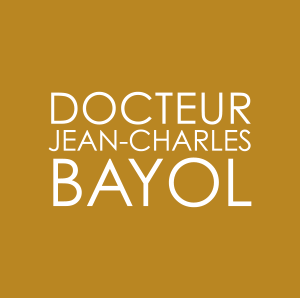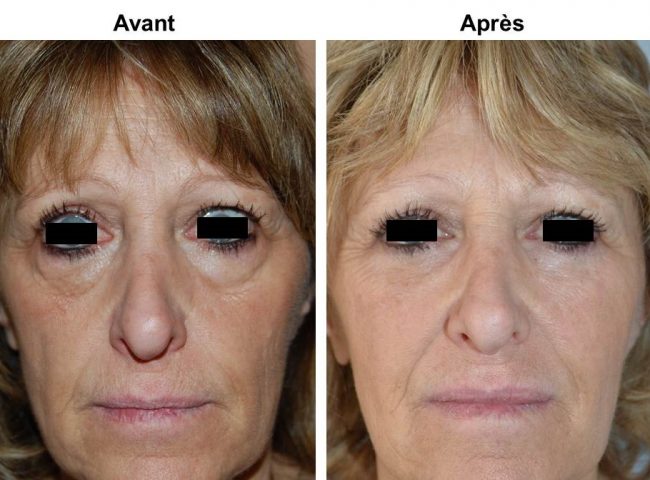MID-FACE LIFT AND CHEEK LIFT
Widening circles, elongation of the lower eyelid, loss of volume of the cheekbones and cheeks, formation of nasolabial folds, appearance of jowls… Inexorably, time condemns facial tissues to relax and fall.The mid face lift helps to fight against these effects and allows to reshape the central part of the face.
> all about MID-FACE LIFT AND CHEEK LIFT <
MID-FACELIFT IN MONTREUX, GENEVA AND LAUSANNE (SWITZERLAND)
The face lift allows the refitting of the muscles and the skin structure of the neck and the side of the cheeks. The mid-facelift corrects the aging of the central part of the face by repositioning its anatomical structures: the lower eyelids, the dark circles and the medial part of the cheeks. This procedure corresponds to an extended version of a lower blepharoplasty.
If your facial defects are corrected by pulling your cheek up in front of a mirror, then a mid-face lift can be considered.
The mid-face lift can be performed alone or in combination with a conventional facial lifting, an adipocyte grafting or a facial lipofilling. Other cosmetic medicine techniques can also be considered such as resurfacing, Botox (botulinum toxin) and injection of filling products such as hyaluronic acid.
BEFORE A MID-FACE LIFT
Like any act of cosmetic surgery, the patient will be seen twice by Doctor Jean-Charles BAYOL at Laclinic-Montreux, or at the Beauty Suite in Lausanne, (30 minutes from Geneva and Fribourg by car). In fact, it is essential to be well informed regarding the modalities of the surgical procedure and the postoperative outcomes of the mid-face lift.
You will meet the anesthetist one to two weeks before the surgical procedure.
As with any surgery, taking aspirin must be prohibited 10 to 15 days before the procedure. You must also refrain from smoking 6 to 8 weeks before the surgery to minimize scarring problems. It is paramount for the surgery to fast the day of the procedure.
ANAESTHESIA AND HOSPITALISATION FOR A MID-FACE LIFT
A mid-face lift can be done under general anesthesia but also under neuroleptic analgesia or conscious sedation (local anesthesia associated with the intravenous administration of anesthetic drugs in small quantities).
This procedure is most often done with an outpatient hospitalization at Laclinic in Montreux, with a check-out on the evening of the surgery. In more rare occasions the hospitalization lasts 24 hours with monitoring night and a check-out the next morning.
THE MID-FACE LIFT PROCEDURE
The mid-face lift is in fact a wider lower blepharoplasty. Several techniques of mid-face lift exist, nevertheless we can keep in mind the following steps:
- Incision In the lower eyelid: below the eyelashes, as in a cosmetic blepharoplasty (Figure 1).
Figure 1: incision et undermining of the mid-face lift
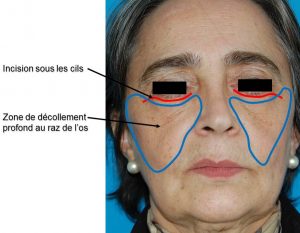
- Deep undermining: through the incision previously made, close to the bone of the entire central region of the face. In order to facilitate this separation, an invisible incision in the mouth can be done (end of the vestibular sac).
- The traction and retightening of the tissues: vertical with absorbable threads. The techniques may differ and there are two possibilities:
-Temporal fixation: after the temporal incision and the temporal separation joining the previous undermin (Figure 2).
Figure 2: Temporal fixation of the mid-face lift
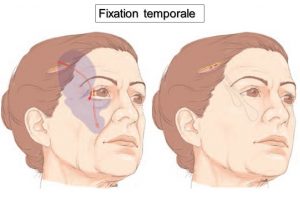
-Fixation on the bony edge of the eye cavity: after making holes in the bone. This technique does not use a temporal incision (Figure 3).
Figure 3: Fixation on the eye-cavity bone
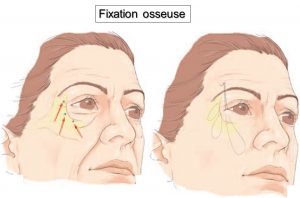
- The procedure ends with the resection of the excess skin in the lower eyelid followed by the suture.
It takes one to two hours to complete this procedure.
THE POSTOPERATIVE OUTCOMES OF THE MID-FACE LIFT
Before being discharged, the patient should be seen the plastic surgeon who will give a prescription of analgesics and several instructions that need to be followed.
Regarding the conventional the frequently observed postoperative outcomes are:
– An overcorrection;
– A Swelling distributed to all of the face (edema). This swelling is at its maximum between the 2nd and 3rd day after the procedure
– Bruises under the eyes and on the cheeks;
– A “cardboard sensation” (numbness) of the central part of the face;
– Slight but unpainful eye flushing (ophthalmic eye drops will be prescribed).
Do not worry about these outcomes, in fact, edema and bruises regress gradually in 2 to 4 weeks. The overcorrection is necessary to a good long-term aesthetic result.
To reduce the size and duration of these postoperative outcomes, you will be systematically supported by the physiotherapy department for post-operative care. It will happen on the same day of the procedure in case of an outpatient hospitalization, or the next day if you stay overnight. Gentle massage of the operated area and LED care will ensure a lymphatic drainage and will promote healing.
Several weeks after surgery, a LPG treatment may be undertaken.
THE RESULTS OF THE MID-FACE LIFT
As with any cosmetic surgery procedure, the final result can be appreciated between 3 and 6 months. The cicatricial result takes longer since a one-year period is necessary to appreciate the outcome. Note that in most cases the scars of the eyelids quickly become very discreet.
The mid-face lift allows to obtain a natural and harmonious rejuvenation bringing a physical and psychological well-being.
This surgery does not stop the aging of the face which will continue but to a lesser extent.
The aesthetic result can be maintained by medical resurfacing treatments (laser, peeling or dermabrasion), injections of hyaluronic acid or botulinum toxin, or a lipotructuring or lipofilling of the face.
IMPERFECTIONS OF THE MID-FACE LIFT IN MONTREUX, LAUSANNE AND GENEVA (SWTZERLAND)
It is important to know that the swelling may persist around the eyelids for more than three months. This edema may require sessions of lymphatic massages and drainages. Postoperative physiotherapy care will make them regress faster.
COMPLICATIONS OF MID-FACE LIFT
Complications that may be related to anesthesia are explained by the anesthesiologist during the preoperative anesthesia consultation.
A mid-face lift is a surgical procedure that involves some rare risks that need to be explained.
Apart from the complications inherent to any surgery (infection, hematoma, scarring complication…), you must know the other risks that may happen:
- Retraction of the lower eyelid (ectropion): The treatment of the ectropion is preventive. It is done by making moderate resection of the skin on the lower eyelid at the end of procedure. Despite moderate resection, when there is a postoperative ectropion, massages usually correct this retraction.
- Nervous lesions:
– Loss of motor functions: Paralysis of the temporal branch of the facial nerve with inability to raise the forehead and eyebrows. Most often this paralysis regresses within weeks, this paralysis is rarely permanen
-Loss of sensitivity: Reduced sensitivity of the cheek and the upper lip, usually regressing in a few weeks.
CONCLUSION
The mid-face lift corresponds to an extended lower extent blepharoplasty. If the indication for surgery is made by a competent cosmetic surgeon, the result of the procedure will be satisfying.
You must be informed by your cosmetic surgeon of the modalities of the procedure, its postoperative outcomes and its risks, even if they are rare.
